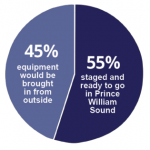A large spill would require equipment brought in from other regions. The Council recently sponsored a study on the availability of equipment on short notice.
The oil industry in Prince William Sound has one of the best-equipped spill prevention and response systems in the world. However, if a big spill were to occur, more equipment would still be needed.
Required equipment
Alaska laws and regulations require Alyeska and the tanker companies to have enough equipment and trained personnel listed in their plans to contain, control, and clean up a spill of 12.6 million gallons of oil within three days. This equipment is staged in Valdez and other areas around the Sound.
But if a greater volume is spilled, industry is expected to recover this too. Alaska law requires industry to note in their oil spill contingency plans where that additional out-of-region equipment will come from.

The State of Alaska also requires Alyeska and the shipping companies to plan for a worst-case discharge, which means having access to enough equipment and trained personnel to clean up 22.9 million gallons of oil* in the shortest time possible.
Approximately 55% of that equipment must be stationed in Prince William Sound. The other 45% would come from other areas.
Once all the equipment stored in Prince William Sound is assigned, there are several options:
- Contracts: Alyeska and each tanker company hold contracts with various oil spill response organizations. These organizations maintain an inventory of equipment, vessels, and personnel, and are contracted to deliver these in a certain window of time.
- Networks: Alyeska and many of the tanker companies are members of networks that share spill response equipment. Some of these are local to Alaska and some include other U.S. states and even a few foreign countries.
- Ad-hoc: State and federal governments maintain stockpiles of equipment. In some cases, these may be released by local officials. Additional equipment from response organizations or other non-contracted sources may also be available. These ad-hoc resources are not guaranteed.
What’s readily available?
The Council worked with Nuka Research to examine how much equipment would need to be brought in, where this equipment would, or could, come from, and what sharing agreements are in place.
A different approach
The Council has done similar surveys, but not since 2007. The analysts at Nuka Research took a different approach from previous studies. They interviewed regulators and response organizations to determine the likely percentage of their equipment they would be able to release.
Other regions must keep enough equipment on hand in case of a spill in their own area, so their capacity to share has limits. Sometimes regulatory approval is needed if sharing leaves their area dangerously under-prepared.
Based on these interviews, Nuka calculated how much equipment would be available if 50% and 25% of the inventory was available to send. They found that oil spill boom and skimmers are readily available, however storage equipment for recovered oil could be limited during a large spill.
The study did not cover whether there would be enough trained personnel to run the equipment, or whether the available boom, skimmers, and storage equipment would have components that are compatible with the existing system.
Read the report
Prince William Sound Out-Of-Region Oil Spill Response Equipment Survey
*The largest tankers in Prince William Sound can hold over 50 million gallons. Industry receives a “prevention credit” for certain spill prevention measures. These measures make a complete loss of total cargo less likely, allowing them to plan for fewer gallons spilled.